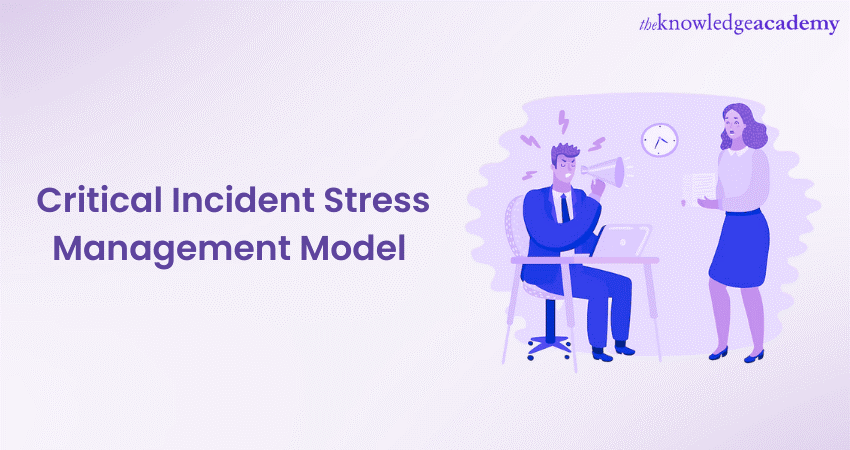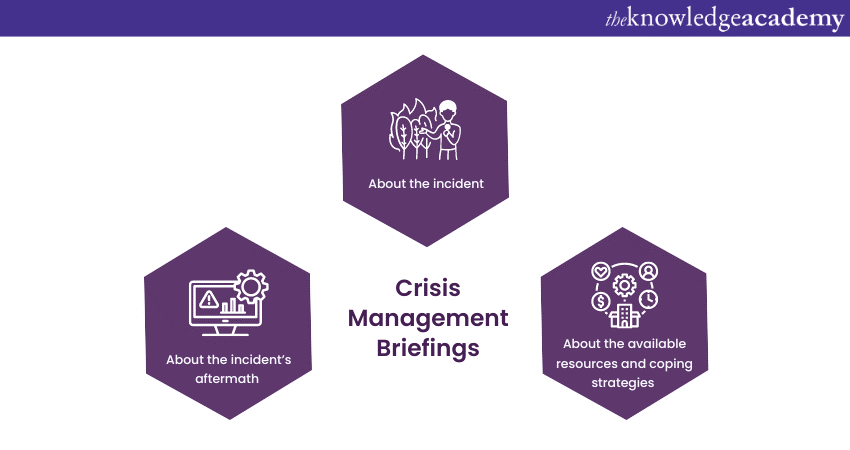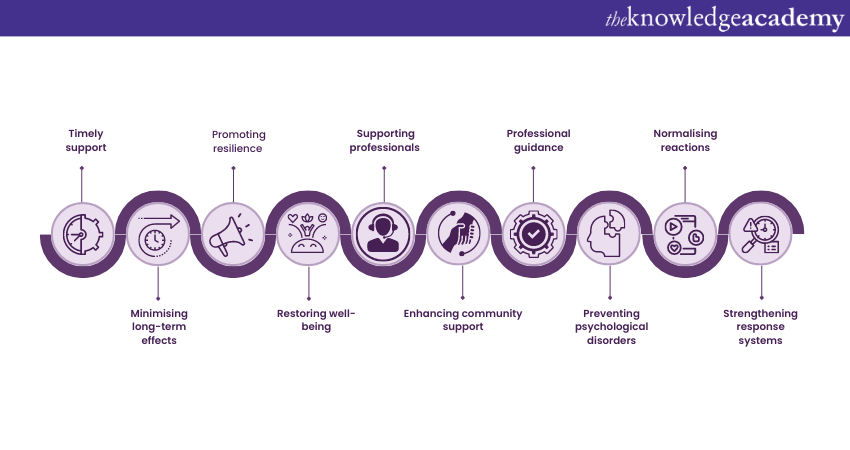We may not have the course you’re looking for. If you enquire or give us a call on +44 1344 203999 and speak to our training experts, we may still be able to help with your training requirements.
We ensure quality, budget-alignment, and timely delivery by our expert instructors.

Life-threatening incidents can occur unexpectedly in this large human society. The aftermath of such incidents can leave people feeling overwhelmed, distressed, and emotionally drained. However, a comprehensive system is designed to acknowledge the emotional and psychological requirements of those affected - the Critical Incident Stress Management Model (CISM).
The Critical Incident Stress Management Model aims to mitigate the potentially harmful effects of trauma and stress by offering a range of interventions and resources. As responsible human beings, it’s crucial to familiarise yourself with this incident model. Also, support and facilitate the healing process for those impacted by critical incidents.
Take the first step today in creating a world worth living. Read this blog to learn about Critical Incident Stress Management Model. Also, explore its components, importance, and applications in different settings respectively.
Table of Contents
1) What is Critical Incident Stress Management (CISM)?
2) Components of the CISM Model
3) How important is Critical Incident Stress Management Model?
4) The role of the Critical Incident Stress Management Model in different settings
5) Conclusion
What is Critical Incident Stress Management (CISM)?
Critical Incident Stress Management is a comprehensive system designed to address the psychological and emotional needs of individuals experiencing a critical incident. The primary goal of this system is to provide timely support and intervention to help individuals navigate the aftermath of an incident.
The system recognises that critical incidents can profoundly impact individuals’ mental health and well-being. The incidents may include natural disasters, accidents, acts of violence, or other traumatic events.
Notably, the critical incident model is not limited to a specific setting or profession. It is applicable to emergency service personnel, workplace environments, military contexts, schools, and educational institutions.
Further, the model recognises that different settings may require personalised approaches to meet the unique needs of individuals and communities. As a result, it promotes healing, resilience, and the restoration of well-being.

Components of the CISM Model
The Critical Incident Model consists of several components that work together to provide comprehensive support to individuals affected by certain incidents. These components ensure a structured approach to addressing the psychological and emotional needs of those impacted. Let's explore the key components of the Critical Incident Stress Management (CISM) model:
1. On-scene support
On-scene support is the immediate assistance provided to individuals involved in a critical incident. Trained professionals offer the following to these individuals:
a) Provide emotional support
b) Assess the needs of those affected
c) Facilitate their access to further assistance
d) Ensure that individuals receive suitable care and support during the initial stages of the incident
2. Critical Incident Stress Debriefing (CISD)
CISD is a formal, structured group discussion that takes place within 24 to 72 hours after the critical incident. It allows individuals to discuss their experiences, emotions, and reactions in a supportive and non-judgmental setting.
Further, through discussions, participants also gain a broader perspective. They learn to normalise their reactions and receive support from peers and mental health professionals.
3. Crisis Management Briefings (CMBs)
These are informational sessions conducted by experts following a critical incident. These briefings aim to provide the following information:

As a result, CMBs help individuals understand their reactions, promote resilience, and provide them with the necessary tools to navigate the challenges they may face.
4. Follow-up support
It involves providing ongoing assistance and support to individuals in the days, weeks, and months following a critical incident. This component ensures that individuals receive continued care, monitoring, and access to appropriate resources. Further, follow-up support may also include the following:
a) Additional counselling sessions
b) Referrals to specialised services
c) Connections to community support networks
5. Pre-incident preparation
Pre-Incident preparation involves proactive measures taken before a critical incident occurs. This component focuses on the following:
a) Training responders
b) Developing response plans
c) Establishing protocols to effectively manage critical incidents
Professionals can be better equipped to provide timely support and intervention when needed by preparing in advance.
6. Defusing
Defusing is a structured intervention that occurs shortly after the critical incident, typically within hours. It provides individuals with an opportunity to:
a) Express their emotions
b) Share their experiences
c) Receive initial support in a safe environment
d) Develop better Stress Management mechanisms
This component aims to prevent the development of more severe stress reactions. As a result, it allows individuals to process their immediate reactions.
Resilience-building
Resilience-building focuses on strengthening individuals’ coping mechanisms and enhancing their ability to deal with future critical incidents. This component may involve the following:
a) Training programs
b) Workshops
c) Exercises designed to improve resilience and psychological well-being
By building resilience, individuals can better navigate the challenges they may encounter in the future.
Discover the transformative learning opportunities that await you with our Personal Development Training.
How important is Critical Incident Stress Management Model?
The Critical Incident Stress Management Model is significant in understanding the psychological and emotional needs of individuals affected by critical incidents. So, let’s explore why CISM is crucial in promoting well-being and facilitating the recovery process:

a) Critical Incident Stress Management Model provides immediate support by addressing an individual’s psychological and emotional needs on time.
b) By offering structured interventions and resources, CISM aims to minimise the long-term psychological effects of trauma and stress.
c) It promotes resilience and also focuses on building resilience in individuals, enhancing their coping mechanisms, and strengthening their ability to deal with future critical incidents.
d) The model helps restore a sense of well-being and normalcy by providing individuals with the necessary tools and support to navigate the aftermath of critical incidents.
e) The critical incident model acknowledges the unique needs of professionals, such as emergency service workers and military personnel.
f) It also provides them with specialised support for Stress Management and trauma associated with their roles.
g) CISM promotes a supportive community environment by fostering open communication, understanding, and empathy among individuals affected by critical incidents.
h) The structured components of CISM provide professionals with a framework to guide their interventions and ensure consistent and effective support.
i) By addressing the immediate psychological needs of individuals, CISM helps prevent potential long-term psychological disorders.
j) The critical incident model normalises individuals’ reactions to critical incidents, helping them understand that their responses are a natural part of the healing process.
k) The implementation of CISM strengthens response systems at various levels, including organisations, communities, and society as a whole.
Unlock the power of effective self-management and interpersonal relationships with our Emotional Intelligence Training.
The role of the Critical Incident Stress Management Model in different settings
The Critical Incident Stress Management (CISM) model plays a crucial role in various settings, recognising that critical incidents can occur in different environments. The following are the various CISM roles across various settings mentioned below:
Emergency services
Emergency service personnel, such as paramedics, firefighters, and police officers, often encounter critical incidents as part of their duties. Here, the critical incident model provides a structured framework to address the psychological and emotional needs of these professionals. Therefore, it ensures their well-being and promotes resilience in challenging situations.
Workplace environments
Critical incidents, including accidents, acts of violence, or natural disasters, can also occur within workplaces. The critical incident model implementation in workplaces acknowledges the impact of such incidents on employees’ mental health. It promotes early intervention, defusing and follow-up support to help employees with Stress Management and cope with trauma and emotional distress.
Military and defence
CISM is vital in supporting military personnel’s mental health and well-being. It provides pre-deployment training, on-scene support, debriefing, and ongoing follow-up services. Therefore, military personnel can better process their experiences build resilience and work towards better Stress Management.
Education sector
Critical incidents, like accidents, violence, or natural disasters, can profoundly impact students, teachers, and staff within educational institutions. CISM implementation in schools recognises the need to address the emotional needs of those affected.
It offers support and interventions tailored to the unique requirements of students and staff. As a result, they can facilitate recovery, reduce stress, and promote a safe and supportive learning environment.
Community support
The critical Incident Stress Management Model extends its reach beyond specific professional settings and encompasses community support. In the aftermath of a critical incident, CISM provides a structure for supporting individuals and promoting their collective well-being.
By offering crisis and Stress Management briefings, community debriefings, and follow-up services, it focuses on addressing the needs of community members. Therefore, building strong communities, healing, and building resilience in adversities.
Healthcare and first responders
The critical incident model also provides support for dealing with traumatic events, Stress Management Strategies, and resources for self-care. CISM implementation in healthcare settings ensures the well-being of providers, enabling them to continue delivering quality care.
Elevate your career in information security! Download the CISM Career Path now and discover how to navigate your path toward certification and success.
Conclusion
The Critical Incident Stress Management Model is valuable for offering compassionate and effective support to individuals affected by critical incidents. It offers a structured and detailed approach to support their well-being, facilitate healing, and promote resilience. Utilising the CISM approach, individuals can pave the way for healing, recovery, and the restoration of well-being.
Take the first step towards managing stress effectively with our Stress Management Training.
Upcoming Business Skills Resources Batches & Dates
Date
 Time Management Training
Time Management Training
Fri 28th Feb 2025
Fri 7th Mar 2025
Fri 23rd May 2025
Fri 18th Jul 2025
Fri 12th Sep 2025
Fri 14th Nov 2025






 Top Rated Course
Top Rated Course


 If you wish to make any changes to your course, please
If you wish to make any changes to your course, please


